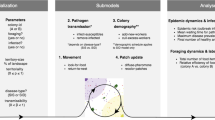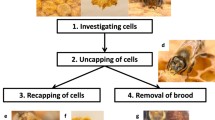Abstract
Understanding the origin of disease resistance in social insects is difficult due to the lack of well-established phylogenies of presocial and eusocial species and the absence of extant basal and intermediate forms. Moreover, comprehensive accounts of infection-control traits in social insect lineages are not available. Therefore, to explore the evolution of pathogen control in social insects we used cellular automata models to analyze the efficacy of immunity and nest hygiene, which we assumed were basal traits, and allogrooming, which likely followed the transition to eusociality, and their interactions with colony demography and patterns of worker spatial distribution. Models showed that nest hygiene provided an immediate survival benefit and that immunity lowered overall disease susceptibility under both constant and periodic exposure scenarios. Allogrooming increased survivorship in chronically challenged colonies but also increased pathogen transmission rates under conditions of periodic exposure. Colonies having demographies biased towards young or old individuals had slightly higher mortality than those with heterogeneous demographies. The distribution of older individuals relative to the nest center had no significant effect on susceptibility and provided only a minor survival advantage. Models indicated that nest hygiene and immunity function on different temporal scales and can interact with demography to lower disease risks. Our results suggest how infection control systems in social insects could have been built upon the inducible immune defenses and nest hygienic behaviors of solitary and presocial ancestors and served as important preadaptations to manage disease exposure and transmission in colonies of eusocial species.




Similar content being viewed by others
References
Abe T, Bignell DE, Higashi M (eds) (2000) Termites: evolution, sociality, symbioses, ecology. Kluwer, Dordrecht
Bienvenu RJ, Atchison FW, Cross EA (1968) Microbial inhibition by prepupae of the alkali bee, Nomia melanderi. J Invertebr Pathol 12:278–282
Brown CR, Brown MB (1986) Ectoparasitism as a cost of coloniality in cliff swallows (Hirundo pyrrhonota). Ecology 67:1206–1218
Bulmer MS, Crozier RH (2004) Duplication and diversifying selection among termite antifungal peptides. Mol Biol Evol 21:2256–2264
Bulmer MS, Crozier RH (2006) Variation in positive selection in termite GNBPs and relish. Mol Biol Evol 23:317–326
Cane JH, Gerdin S, Wife G (1983) Mandibular gland secretions of solitary bees (Hymenoptera; Apoidea): potential for nest cell disinfection. J Kans Entomol Soc 56:199–204
Castle GB (1934) The dampwood termites of western United States, genus Zootermopsis (formerly, Termopsis). In: Kofoid CA (ed) Termites and termite control. University of California, Berkeley, pp 273–310
Duwel-Eby LE, Faulhaber LM, Karp RD (1991) Adaptive humoral immunity in the American cockroach. In: Gupta AP (ed) Immunology of insects and other arthropods. CRC, Boca Raton, FL, pp 385–402
Du Pasquier L, Flajnik M (1999) Origin and evolution of the vertebrate immune system. In: Paul W (ed) Fundamental immunology, 4th edn. pp 605–650
Fernandez-Marin H, Zimmerman JK, Wcislo WT (2003) Nest-founding in Acromyrmex octospinosus (Hymenoptera, Formicidae, Attini): demography and putative prophylactic behaviors. Insectes Soc 50:304–308
Fernandez-Marin H, Zimmerman JK, Wcislo WT (2004) Ecological traits and evolutionary sequence of nest establishment in fungus-growing ants (Hymenoptera, Formicidae, Attini). Biol J Linn Soc 81:39–48
Fernandez-Marin H, Zimmerman JK, Wcislo WT, Rehner SA (2005) Colony foundation, nest architecture and demography of a basal fungus-growing ant, Mycocepurus smithii (Hymenoptera, Formicidae). J Nat Hist 39:1735–1743
Field J, Brace S (2004) Pre-social benefits of extended parental care. Nature 428:650–652
Hultmark D (1993) Immune reactions in Drosophila and other insects: a model for innate immunity. Trends Genet 9:178–184
Hölldobler B, Wilson EO (1990) The ants. Harvard University Press, Cambridge
Kaltenpoth M, Gottler W, Herzner G, Strohm E (2005) Symbiotic bacteria protect wasp larvae from fungal infestation. Curr Biol 15:475–479
Loehle C (1995) Social barriers to pathogen transmission in wild animal populations. Ecology 76:326–335
McCarthy MA, Thompson C (2001) Expected minimum population size as a measure of threat. Anim Conserv 4:351–355
Moret Y, Schmid-Hempel P (2004) Social life-history response to individual immune challenge of workers of Bombus terrestris L.: a possible new cooperative phenomenon. Ecol Lett 7:146–152
Naug D, Camazine S (2002) The role of colony organization on pathogen transmission in social insects. J Theor Biol 215:427–439
Nelson KE, Williams CM, Graham NMH (2001) Infectious diseases epidemiology, theory and practice. Aspen, Maryland
Nunn CL, Gittleman JL, Antonovics J (2000) Promiscuity and the primate immune system. Science 290:1168–1170
Pancer Z, Amemiya CT, Ehrhardt GRA, Celtllin J, Gartland GL, Cooper MD (2004) Somatic diversification of variable lymphocyte receptors in the agnathan sea lamprey. Nature 430:174–180
Pie MR, Rosengaus RB, Traniello JFA (2004) Nest architecture, activity pattern, worker density and the dynamics of disease transmission in social insects. J Theor Biol 226:45–51
Rhodes CJ, Anderson RM (1996) Persistence and dynamics in lattice models of epidemic spread. J Theor Biol 180:125–133
Rosengaus RB, Traniello JFA (1991) Biparental care in incipient colonies of the dampwood termite Zootermopsis angusticollis Hagen (Isoptera: Termopsidae). J Insect Behav 4:633–647
Rosengaus RB, Traniello JFA (1997) Pathobiology and disease transmission in dampwood termites Zootermopsis angusticollis (Isoptera: Termopsidae) infected with the fungus Metarhizium anisopliae (Deuteromycotina: Hypomycetes). Sociobiology 30:185–195
Rosengaus RB, Traniello JFA (2001) Disease susceptibility and the adaptive nature of colony demography in the dampwood termite Zootermopsis angusticollis. Behav Ecol Sociobiol 50:546–556
Rosengaus RB, Maxmen AB, Coates LE, Traniello JFA (1998) Disease resistance: a benefit of sociality in the dampwood termite Zootermopsis angusticollis (Isoptera: Termopsidae). Behav Ecol Sociobiol 44:125–134
Rosengaus RB, Traniello JFA, Chen T, Brown JJ, Karp RD (1999) Immunity in a social insect. Naturwissenschaften 86:588–591
Sanchez-Villagra MR, Pope TR, Salas V (1998) Relation of intergroup variation in allogrooming to group social structure and ectoparasite loads in red howlers (Alouatta seniculus). Int J Primatol 19:473–491
Schmid-Hempel P (1998) Parasites in social insects. Princeton University Press, Princeton
Seelinger G, Seelinger U (1983) On the social organization, alarm and fighting in the primitive cockroach Cryptocercus punctulatus Scudder. Z Tierpsychol 61:315–333
Strohm E, Linsenmair KE (2001) Females of the European beewolf preserve their honeybee prey against competing fungi. Ecol Entomol 26:198–203
Thorne BL, Traniello JFA (2003) Comparative social biology of basal taxa of ants and termites. Annu Rev Entomol 48:283–306
Traniello JFA, Rosengaus RB, Savoie K (2002) The development of immunity in a social insect: evidence for the group facilitation of disease resistance. Proc Natl Acad Sci USA 99:6838–6842
Wilson EO (1971) The insect societies. Harvard University Press, Cambridge
Wilson K, Cotter SC (2004) Density dependent prophylaxis in insects. In: Ananthakrishana TN, Whitman TW (eds) Insects and phenotypic plasticity. Science, Enfield
Wilson K, Reeson AF (1998) Density-dependent prophylaxis: evidence from Lepidoptera–baculovirus interactions. Ecol Entomol 23:100–101
Wilson K, Thomas MB, Blanford S, Doggett M, Simpson SJ, Moore SL (2002) Coping with crowds: density-dependent disease resistance in desert locusts. Proc Natl Acad Sci USA 99:5471–5475
Acknowledgements
We thank M. Pie and anonymous reviewers for helpful comments and J. M. Reed for his help in the preparation of the figures. This work was funded by NSF Grant IBN-0116857 to J.F.A.T. and R.B.R. We thank the 2nd International Workshop on the Mathematics and Algorithms of Social Insects and the DARPA/DSO 2004 Workshop on Endogenous Defense for travel funding.
Author information
Authors and Affiliations
Corresponding author
Additional information
Communicated by L. Sundström
Appendix 1: Model details
Appendix 1: Model details
Primary exposure
Constant exposure was defined as the continual presence of infection (such as fungal conidia or bacteria) in 20 cells, chosen at random in each iteration and lasting 1–10 days in each cell. Periodic exposure was defined as the presence of an infective agent in 70 cells chosen at random every 900 iterations (3 months). These cells continued to be infectious for 100 iterations (10 days) after which they no longer held primary contagion. The duration of contagion in these cells in both types of primary exposure was arbitrary, thus allowing us to explore the impact of disease over time.
While primary exposure can be thought of as the novel introduction of pathogen into the nest from an external source, it can also be introduced via the internal source of dead individuals. Although we discuss the results of our model as though dead workers were quarantined, removed from the nest or buried and therefore incapable of infecting nestmates via social interaction, our results can also be interpreted as though primary exposure resulted from a failure to remove infected corpses. To examine whether or not our results would differ if all introduction were from external sources, we examined the same scenarios of disease spread while restricting the incidence of primary exposure to the periphery of the nest (within two cells of the maximum r). This restriction had no effect on survival, and these models are not presented.
Workers development and mobility
To stimulate normal colony growth, 25 eggs were added every 300 iterations (≅ to 30 days) in accordance with some observed patterns of oviposition in small social insect colonies (Castle 1934), though any pattern of oviposition (e.g., single large groups of eggs with synchronous maturation before subsequent oviposition, or overlapping generations) can be used if it is held constant across experimental models (Fefferman et al., in preparation). Workers aged during each iteration and after an appropriate number of iterations in a given developmental stage (Rosengaus and Traniello 2001; see Table 2) workers progressed to the next stage until reaching ‘adulthood’. Initially, first and second instar larvae did not move away from the center of the nest, but as they matured, they were allowed to move “outward” by one cell to avoid an artificially dense nest center and emulate the often centripetal age-related movement of workers. These restrictions on movement reflect the limited mobility of young larvae in natural colonies of termites and most species of social Hymenoptera (Wilson 1971).
Topology, colony size, and denisty
All models defined a simplified, two-dimensional circular nest with ∼10,000 “cells” or discrete areas through which an initial population of 1,000 “workers” could move and interact. No restriction was made on the number of workers occupying a single cell at a time and workers were only able to interact if they occupied the same cell. Colony size should not impact the results of our model because colony size and nest size are seen to vary proportionally in natural settings. Therefore, density and its concomitant effect on nestmate interaction rates should remain constant. To reflect ontogenic changes, our model focused on demographic distribution rather than colony size per se.
Rights and permissions
About this article
Cite this article
Fefferman, N.H., Traniello, J.F.A., Rosengaus, R.B. et al. Disease prevention and resistance in social insects: modeling the survival consequences of immunity, hygienic behavior, and colony organization. Behav Ecol Sociobiol 61, 565–577 (2007). https://doi.org/10.1007/s00265-006-0285-y
Received:
Revised:
Accepted:
Published:
Issue Date:
DOI: https://doi.org/10.1007/s00265-006-0285-y




